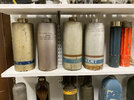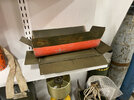pzgr40
Well-Known Member
Cutaway model of an American M56 dispenser AT/AV (Anti Tank/ Anti Vehiclular) mine. This mine is one of the first dispenser mines in use and was delivered by means of a UH-1H Huey helicopter that carried two SUU-13AD/A dispenser boxes, one on each side. The disadvantage of this type of mine is that it can be easily observed on the surface as it is not burried, the advantage however is that a minefield can be laid fast and deep into enemy terratory upon a commanders request, severely hindering enemy movement.
The SUU-13D/A dispenser houses 40 vertical pipes, each housing two M56 mines and a M198 expulsion charge (picture 10), so in total one helicopter transports 160 mines in the two dispensers. On average one helicopter lays a minefield 400 meters long and 40 meters wide, however the minefield density is descided by the expulsion frequency and the speed of the helicopter which can be varied by the DCP (Dispenser Control Panel) in the cockpit of the helicopter.
Soon one found out that a helicopter was not the ideal means for laying a minefield as a low and slow flying helicopter in or around enemy territory is vurnerable to even rifle fire, also, a helicopter had to be available and one was also dependant on the weather. So the use of artillery, rockets and clusterbombs to lay remote minefields wss introduced.
The M56 mine has been in use by the US army from 1964 to 1977 after which it was phased out, to be replaced by the BLU-91/B Gator mine (in the CBU 89/B clusterbomb) around 1980, the RAAM (Remote Anti Armour Mining system) which is fired from 155mm shells, and the Volcano mine dispenser system which is used from vehicles as well as from helicopters. Another advantage of these newer mines is that they are full width mines using an EFP (Explosively Formed Penetrator), and the M56 mine is a contact mine, so track or tyre activated only.
The body of the mine is fully Aluminium made (pictures 01 & 02) and consists of half a cilinder to which a pressure plate -mounted in a rubber rim- (picture 03) with four spring loaded rectangular fins hinged on the outer circumference of the plate is mounted. The assembly is connected to the flat underside of the mine body by means of small screws. After a set of two mines is expulsed from the vertical pipe the fins are pushed open by the springs and this pushes the mines apart, and the fins orientate the mines to end up on the ground with the pressure plate upward.
The fuze (pictures 05 &06 ) consists of an aluminium cast piece (pos 01) to which the main components of the fuze are connected or placed in. The housing for the detonator slider (pos 2) is screwed to the casting (pos 01), the timer and electronics block (pos 03) is also placed in the cast piece, as well as the battery (pos 04). The fuze is locked up in the mine body by means of a screw on cap on the end of the mine body.
The mechanical safety consists of a spring loaded bore rider pin that moves outward as soon as the mine is ejected from the pipe, allowing the safety slider (pos 5) to move the detonator (pos 6) in line with the Hexogen booster that protrudes in the main charge (grey).
By moving the safety slider in the armed position, an electronic switch (pos 08) is also closed, starting the electric arming cyclus of the mine. The timer waits two minutes before arming the mine to alow the mine to come to rest and after two minutes the mine is armed and live. If a vehicle drives over the mine with a track or wheel the pressure plate will be pressed inward against the four springs (picture 08, pos 10) and the pressure plate will push inwards the electric switch (picture 08, pos 9). This will ignite the electric detonator placed in the detonator housing (pos 2) behind the detonator in the slider (pos 6) which will ignite the booster and the main charge.
The mine has a self destruct mechanism that consists of a timer module and a low voltage detector (LVD) that destroys the mine if the time has expired or the voltage in the battery becomes too low. Normally this will be between 38 to 48 hours. Some mines have an anti tampering device that will explode the mine if moved (a mercury swich?). All mines will explode if an attempt is made to remove the battery.
The M56 mine is too light to destroy a tank, but it is an effective track breaker. This will delay a tank for several hours due to track reapair. When AV (Anti Vehicular), it twill rip of the wheel and the drive shaft of a truck or car resulting in extensive repairs.
Data :
Length : 264mm (10 3/8”)
Diameter : 118mm (4 5/8”)
Lenth x width with spring folded fins out: 350 x 205mm
weight : 2,54 kg (5,9 pounds)
weight explosive charge : 1,36 kg H6
Regards, DJH
An interesting detail; this mine type sometimes appears on the internet or collectors meetings, but allways the wooden dummy. These come from East-German (DDR) instruction boxes with instruction models of NATO scaterable mines, meant to teach the NVA military (Picture 11).
The SUU-13D/A dispenser houses 40 vertical pipes, each housing two M56 mines and a M198 expulsion charge (picture 10), so in total one helicopter transports 160 mines in the two dispensers. On average one helicopter lays a minefield 400 meters long and 40 meters wide, however the minefield density is descided by the expulsion frequency and the speed of the helicopter which can be varied by the DCP (Dispenser Control Panel) in the cockpit of the helicopter.
Soon one found out that a helicopter was not the ideal means for laying a minefield as a low and slow flying helicopter in or around enemy territory is vurnerable to even rifle fire, also, a helicopter had to be available and one was also dependant on the weather. So the use of artillery, rockets and clusterbombs to lay remote minefields wss introduced.
The M56 mine has been in use by the US army from 1964 to 1977 after which it was phased out, to be replaced by the BLU-91/B Gator mine (in the CBU 89/B clusterbomb) around 1980, the RAAM (Remote Anti Armour Mining system) which is fired from 155mm shells, and the Volcano mine dispenser system which is used from vehicles as well as from helicopters. Another advantage of these newer mines is that they are full width mines using an EFP (Explosively Formed Penetrator), and the M56 mine is a contact mine, so track or tyre activated only.
The body of the mine is fully Aluminium made (pictures 01 & 02) and consists of half a cilinder to which a pressure plate -mounted in a rubber rim- (picture 03) with four spring loaded rectangular fins hinged on the outer circumference of the plate is mounted. The assembly is connected to the flat underside of the mine body by means of small screws. After a set of two mines is expulsed from the vertical pipe the fins are pushed open by the springs and this pushes the mines apart, and the fins orientate the mines to end up on the ground with the pressure plate upward.
The fuze (pictures 05 &06 ) consists of an aluminium cast piece (pos 01) to which the main components of the fuze are connected or placed in. The housing for the detonator slider (pos 2) is screwed to the casting (pos 01), the timer and electronics block (pos 03) is also placed in the cast piece, as well as the battery (pos 04). The fuze is locked up in the mine body by means of a screw on cap on the end of the mine body.
The mechanical safety consists of a spring loaded bore rider pin that moves outward as soon as the mine is ejected from the pipe, allowing the safety slider (pos 5) to move the detonator (pos 6) in line with the Hexogen booster that protrudes in the main charge (grey).
By moving the safety slider in the armed position, an electronic switch (pos 08) is also closed, starting the electric arming cyclus of the mine. The timer waits two minutes before arming the mine to alow the mine to come to rest and after two minutes the mine is armed and live. If a vehicle drives over the mine with a track or wheel the pressure plate will be pressed inward against the four springs (picture 08, pos 10) and the pressure plate will push inwards the electric switch (picture 08, pos 9). This will ignite the electric detonator placed in the detonator housing (pos 2) behind the detonator in the slider (pos 6) which will ignite the booster and the main charge.
The mine has a self destruct mechanism that consists of a timer module and a low voltage detector (LVD) that destroys the mine if the time has expired or the voltage in the battery becomes too low. Normally this will be between 38 to 48 hours. Some mines have an anti tampering device that will explode the mine if moved (a mercury swich?). All mines will explode if an attempt is made to remove the battery.
The M56 mine is too light to destroy a tank, but it is an effective track breaker. This will delay a tank for several hours due to track reapair. When AV (Anti Vehicular), it twill rip of the wheel and the drive shaft of a truck or car resulting in extensive repairs.
Data :
Length : 264mm (10 3/8”)
Diameter : 118mm (4 5/8”)
Lenth x width with spring folded fins out: 350 x 205mm
weight : 2,54 kg (5,9 pounds)
weight explosive charge : 1,36 kg H6
Regards, DJH
An interesting detail; this mine type sometimes appears on the internet or collectors meetings, but allways the wooden dummy. These come from East-German (DDR) instruction boxes with instruction models of NATO scaterable mines, meant to teach the NVA military (Picture 11).
Attachments
-
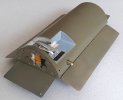 01 - M56 strooimijn, zijde met electromechanische ontsteker.jpg721.4 KB · Views: 60
01 - M56 strooimijn, zijde met electromechanische ontsteker.jpg721.4 KB · Views: 60 -
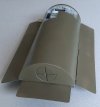 02 - M56 strooimijn , zijde met vuldop springlading.jpg580.2 KB · Views: 58
02 - M56 strooimijn , zijde met vuldop springlading.jpg580.2 KB · Views: 58 -
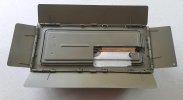 03 - M56 strooimijn, onderzijde met drukplaat.jpg1 MB · Views: 52
03 - M56 strooimijn, onderzijde met drukplaat.jpg1 MB · Views: 52 -
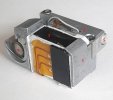 04 - M56 strooimijn ontsteker.jpg459 KB · Views: 53
04 - M56 strooimijn ontsteker.jpg459 KB · Views: 53 -
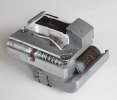 05 - M56 strooimijn ontsteker.jpg462.8 KB · Views: 52
05 - M56 strooimijn ontsteker.jpg462.8 KB · Views: 52 -
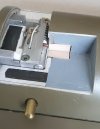 06 - M56 strooimijn ontsteker in mijnlichaam detail.jpg982.8 KB · Views: 52
06 - M56 strooimijn ontsteker in mijnlichaam detail.jpg982.8 KB · Views: 52 -
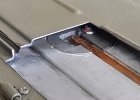 07 - M56 strooimijn elektrische drukschakelaar.jpg671.2 KB · Views: 52
07 - M56 strooimijn elektrische drukschakelaar.jpg671.2 KB · Views: 52 -
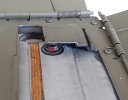 08 - M56 strooimijn veren onder drukplaat.jpg642.7 KB · Views: 53
08 - M56 strooimijn veren onder drukplaat.jpg642.7 KB · Views: 53 -
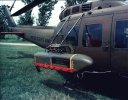 09 - SUU-13A dispenser aan UH-1 Huey.jpg246.5 KB · Views: 46
09 - SUU-13A dispenser aan UH-1 Huey.jpg246.5 KB · Views: 46 -
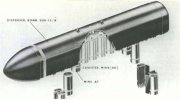 10 - SUU-13A dispenser doorsnede.jpg43.1 KB · Views: 59
10 - SUU-13A dispenser doorsnede.jpg43.1 KB · Views: 59

